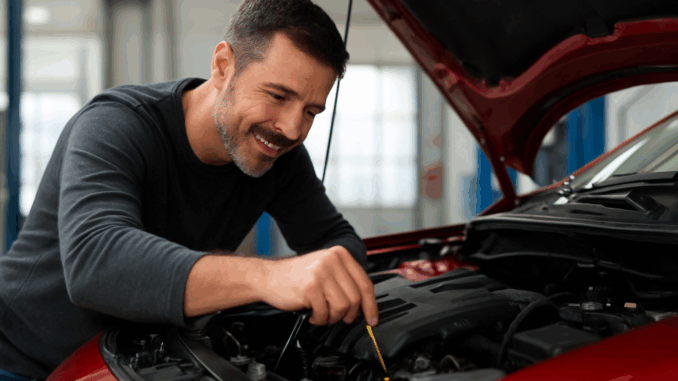
Top 10 Car Maintenance Tips to Keep Your Vehicle Running Smoothly in 2025
As technology evolves and vehicles become more advanced, maintaining your car in 2025 requires more than just an occasional oil change. From hybrid systems to advanced driver-assistance features, modern vehicles demand proper care to ensure safety, efficiency, and longevity. Regular maintenance not only prevents costly repairs but also enhances performance and fuel economy.
In this article, we’ll cover the top 10 car maintenance tips to help your vehicle run smoothly throughout 2025 and beyond.
1. Check and Change Your Engine Oil Regularly
The engine is the heart of your vehicle, and engine oil is its lifeblood. Oil lubricates the moving parts, reduces friction, and prevents overheating. Over time, oil breaks down and becomes contaminated with dirt and debris, which can cause engine wear and tear.
How Often Should You Change It?
- For conventional oil, every 3,000 to 5,000 miles.
- For synthetic oil, every 7,000 to 10,000 miles, depending on driving conditions and manufacturer recommendations.
Make it a habit to check the oil level at least once a month. If you notice dark, thick oil or low levels, it’s time for a change. Also, always replace the oil filter during every oil change to ensure clean lubrication.
2. Keep Your Tires in Top Condition
Your tires are your vehicle’s only contact with the road, making them crucial for safety, handling, and fuel efficiency. Poorly maintained tires can lead to blowouts, uneven wear, and reduced gas mileage.
Tire Care Tips:
- Check tire pressure monthly using a reliable gauge. Follow the manufacturer’s recommended PSI (found in your car manual or door jamb).
- Rotate your tires every 6,000 to 8,000 miles to promote even wear.
- Inspect tread depth — tires should have at least 2/32 inch (1.6 mm) of tread. Replace them if worn.
- Don’t forget the spare tire — ensure it’s inflated and in good condition.
Properly inflated tires can improve your fuel economy by up to 3%, which adds up over time.
3. Replace Air Filters Regularly
Clean air filters keep your engine breathing efficiently. A clogged filter restricts airflow, reducing performance and increasing fuel consumption.
Types of Filters to Check:
- Engine air filter: Replace every 12,000 to 15,000 miles, or as recommended.
- Cabin air filter: Essential for keeping the air inside your car clean. Replace every 15,000 to 20,000 miles, especially if you drive in dusty or polluted areas.
A new air filter can improve acceleration and fuel efficiency — a small maintenance step with big results.
4. Monitor Fluid Levels
Your car depends on various fluids to operate smoothly. Neglecting them can lead to breakdowns and costly repairs.
Essential Fluids to Check:
- Engine oil
- Coolant (antifreeze)
- Brake fluid
- Transmission fluid
- Power steering fluid
- Windshield washer fluid
Check these at least once a month or before long trips. Low or dirty fluids can indicate leaks or other mechanical problems. Always use the correct type of fluid recommended by your vehicle’s manufacturer.
5. Inspect and Replace Spark Plugs
Spark plugs are small but essential for engine performance. They ignite the air-fuel mixture that powers your engine. Over time, spark plugs can wear out, causing misfires, reduced power, and poor fuel economy.
Most spark plugs last 60,000 to 100,000 miles, depending on type and vehicle. If your car is hard to start, idles roughly, or accelerates sluggishly, faulty spark plugs might be the culprit. Replacing them can restore smooth performance and efficiency.
6. Check Your Battery Health
In 2025, car batteries power more electronics than ever — from infotainment systems to advanced sensors. A weak battery can cause electrical issues or prevent your car from starting.
Battery Maintenance Tips:
- Inspect terminals for corrosion and clean them with a wire brush.
- Check voltage regularly — a healthy battery should read around 12.6 volts when fully charged.
- Replace your battery every 3 to 5 years, or sooner if you experience slow starts or dimming lights.
If you drive a hybrid or electric vehicle (EV), follow the manufacturer’s guidelines for battery care to preserve long-term performance.
7. Keep the Braking System in Check
Your brakes are your vehicle’s most important safety feature. Ignoring brake maintenance can lead to serious accidents or expensive repairs.
Warning Signs of Brake Issues:
- Squeaking or grinding noises
- Soft or spongy brake pedal
- Vibrations when braking
- Longer stopping distances
Have your brake pads, rotors, and brake fluid inspected at least once a year. Brake pads typically last 25,000 to 70,000 miles, depending on driving habits. If you drive in heavy traffic or mountainous areas, check them more often.
8. Maintain the Cooling System
Overheating is one of the most common causes of engine failure. Your cooling system — consisting of the radiator, coolant, water pump, and hoses — regulates the engine’s temperature.
To prevent overheating:
- Check coolant levels regularly and top up when needed.
- Flush the coolant system every 2 to 3 years, or as recommended.
- Inspect hoses for cracks or leaks.
Never open the radiator cap while the engine is hot — always wait until it cools down to avoid burns or injury.
9. Pay Attention to Warning Lights
Modern cars come equipped with advanced onboard diagnostics (OBD) systems that alert you to potential issues. Never ignore a dashboard warning light — it’s your car’s way of asking for help.
Common Warning Lights:
- Check Engine Light — could indicate anything from a loose gas cap to a serious engine issue.
- Oil Pressure Light — low oil or a problem with the oil pump.
- Battery Light — charging system malfunction.
- Brake Light — low brake fluid or worn pads.
If a warning light appears, check your owner’s manual for details or visit a mechanic promptly. Catching problems early can prevent major repairs.
10. Keep Up with Scheduled Maintenance
Every vehicle comes with a manufacturer-recommended maintenance schedule — typically outlined in the owner’s manual. This includes mileage-based inspections and replacements for fluids, filters, belts, and more.
Regular servicing ensures your car remains in top shape and helps maintain your warranty coverage. You can also use digital reminders or maintenance apps to keep track of due dates and avoid missing important services.
Bonus Tip: Keep It Clean
Washing and waxing your car might seem cosmetic, but it’s also part of maintenance. Dirt, salt, and debris can damage paint and cause rust over time.
Car Cleaning Tips:
- Wash your car at least twice a month.
- Wax every 3–6 months for extra protection.
- Clean the interior to prevent wear on upholstery and electronics.
A clean car not only looks great but also retains higher resale value.
Final Thoughts
Car maintenance in 2025 is about being proactive rather than reactive. With vehicles becoming more sophisticated — featuring sensors, hybrid engines, and electronic systems — regular care is crucial for reliability and performance.
By following these top 10 car maintenance tips, you’ll extend your vehicle’s lifespan, improve fuel efficiency, and ensure a safe and smooth driving experience.
Remember: a little attention now can save you a lot of money and headaches down the road. Keep your car in excellent condition, and it will reward you with years of dependable service.

